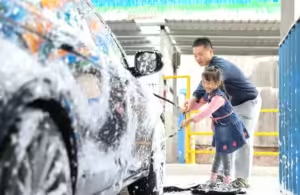Car wash tips are an invaluable source of income and serve as positive feedback on an employee’s work quality. In areas where tipping is common practice, rewarding workers who provide exceptional attention to detail with tips is a common practice that rewards exceptional service workers.
Remove any jewelry that could scratch the paint, such as rings, watches and belt buckles. Zip-up hoodies with buttons may also cause surface scratching to the finish.
Washing
Car washing can protect the finish, reduce rust over time and maintain its appearance – but done improperly it could leave behind water spots and scratch marks that mar the paint job and glass surfaces.
Start by giving your vehicle a pre-soak using either a hose or bucket filled with clean, lukewarm water to soften bird droppings, bugs, leaves and other debris such as bird droppings. Rinse thoroughly to remove loose dirt before giving special attention to stubborn stains or bird droppings that need special cleaning attention.
Always choose quality car-wash soap instead of dish or laundry detergent products, as these contain strong chemicals that could compromise the finish of your vehicle. Always follow manufacturer directions when applying and mixing, such as mixing 20 parts water to one part soap for instance.
Work in small sections, beginning with the roof and working your way down while rinsing each time. Remember to include wheels since these often get filthiest. If possible, work under shade as direct sunlight can cause soap-and-water mixtures to set before being rinsed away easily.
Avoid moving your mitt or sponge in circles as this can leave fine scratches that are hard to repair. Instead, wash either straight lines or in a Z-pattern, whatever makes for easier washing.
Rinsing
After washing your car with soap, be sure to thoroughly rinse it afterward to prevent soap residue from drying on its paint and leaving unsightly water spots later. For best results, it is advisable to do this step in shade instead of direct sunlight as direct sunlight speeds up drying times and may leave unsightly streaks or deposits that tarnish its finish.
Make use of distilled water when washing your car; tap water contains minerals which may harm its paint finish. Furthermore, try switching over to microfibre towels instead of regular ones to remove soapy film more efficiently; they can be wiped clean after every use without leaving lint behind.
Do not scrub your car in circular motions as this could result in fine, light scratches that are difficult to repair. Instead, move your sponge or towel in straight lines or Z-patterns that make it easier if any scratches occur accidentally.
Maintain a bucket of clean water nearby to easily wash hoses, sponges and microfibre towels when they become filthy. Furthermore, rinse any used tools or towels thoroughly until all impurities have been rinsed away and they’re completely dry – this ensures any dirt particles or lint are left behind in the rinse bucket rather than sticking around on your clean microfibre towel! For stubborn spots on your car that prove hard to remove using only cleaner methods alone, apply rubbing alcohol directly onto them and let soak-in over time until eventually leaving you with results!
Drying
Deliberate car drying may appear like an unnecessary step during the car washing process, but it is actually essential. By investing in professional drying tools and techniques you will ensure your freshly washed vehicle remains looking like new once on the road.
To avoid water spots on your car exterior, begin by using a garden hose to rinse its entirety before wiping down its surface with a soft microfiber towel soaked with soapy water from a shower head. Use another microfiber towel to wipe down each section – from roof, hood and rear of vehicle, upper portion of each side then lower portion until all are completed – always washing wheels/tires last as brake dust can easily scratch paintwork.
For optimal results, professional auto detailers often employ soft microfiber towels or synthetic chamois when drying their vehicles after washing. This technique will leave a streak-free shine to your car’s finish. If using the drying station at a car wash, make sure your towels are clean (or bring your own), as other cars’ grime could soil their towels quickly.
Declutter the interior to avoid trash build-up and use cup holder liners to prevent sticky substances from getting trapped between washes. Also make sure that you rinse your windshield often and use quality glass cleaner to prevent hard water spots forming on it – the busier your driving route and dirtier its local roads are, the more frequently your car should be washed for optimal appearance.
Waxing
Waxing is one of the best ways to safeguard your car. Not only does it shield it against potential damages and contaminants, but also enhances its appearance and appearance.
Before waxing your car, always read and follow the product instructions closely. This will enable you to select an appropriate type of wax such as liquid, paste or cream for its specific needs. Paste waxes provide long-term protection that typically lasts three to six months while cream and liquid waxes tend to be easier to apply and remove while possibly not providing as long a period of protection as their paste counterparts.
Once you’ve read and selected a type of wax, apply it to a clean, dry surface. For optimal results, wax in shaded areas. If this isn’t possible, work in small sections at a time to avoid overworking the paint.
When applying wax, use either a microfiber applicator pad or terry cloth detailing towel for even coverage without risk of scratching paint surfaces with rough towels. If your product doesn’t include an applicator pad, a damp sponge will do just as well – once it has been applied and polished to a shine, allow it to cure for as long as your product specifies.

